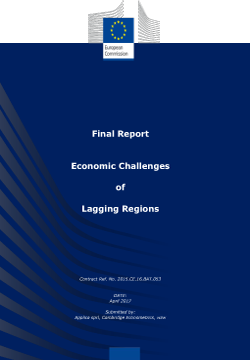Economic Challenges of Lagging Regions

Reports
Date: 04 oct 2017
Theme: Business support, Research and innnovation, Research & Development, Social inclusion, Jobs, Education and Training, Structural Funds management and Governance
Languages: en
The focus of the study is the economic challenges of lagging regions in the EU-28. In this respect, regions - in general – are defined according to the NUTS2 level of regions1. As far as lagging regions are concerned, there are two specific types:
- Low growth regions, i.e. those NUTS2 regions that did not converge to the EU average GDP per head at PPS between the years 2000 and 2013. This group covers almost all the less developed and transition regions in Greece, Italy, Spain and Portugal.
- Low income regions, i.e. those NUTS2 regions with a GDP per head in PPS below 50% of the EU average in 2013. This group covers several less developed regions of Bulgaria, Hungary, Poland and Romania.
The main challenge regarding the low growth regions is to find policies and strategies to overcome the low growth path they have been locked-in for more than a decade. The main challenge of the low income regions is the long-term sustainability of the respectable growth-path they have been following in past and the need to prevent them from entering the development trajectory of the low growth regions. Overall therefore, the major challenge of the lagging regions is to increase and/or stabilise their economic performance in order to enable to re-enter and stay on a convergence path to the more prosperous regions in the EU.
Annexes
- Annex 1 - Task 1: Country case studies en
- Annex 2 - Task 2: Country report SPAIN en
- Annex 2 - Task 2 - Country report BULGARIA en
- Annex 2 -Task 2: Country report GREECE en
- Annex 2 - Task 2: Country report HUNGARY en
- Annex 2 - Task 2: Country report ITALY en
- Annex 2 - Task 2: Country report POLAND en
- Annex 2 - Task 2: Country report PORTUGAL en
- Annex 2 - Task 2: Country report ROMANIA en
